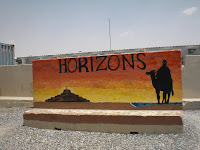Shown below is a soldier painting his company's crest on a wall. Large cement barriers are common on bases throughout Southwest Asia. Used primarily as blast protection for buildings and other structures. T-Walls number in the hundreds on any given base.


 Troop members painted this to remember the loss of victims of Flight 93.
Troop members painted this to remember the loss of victims of Flight 93.








